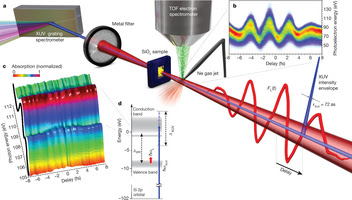

| Visitors Now: | |
| Total Visits: | |
| Total Stories: |

| Story Views | |
| Now: | |
| Last Hour: | |
| Last 24 Hours: | |
| Total: | |
Laser Pulse Controlled Petahertz Transistors could become 10 thousand times faster than todays transistors
From
A discovery that promises transistors – the fundamental part of all modern electronics – controlled by laser pulses that will be 10,000 faster than today’s fastest transistors has been made by a Georgia State University professor and international researchers.
There are three basic types of solids: metals, semiconductors, used in today’s transistors, and insulators – also called dielectrics.
Dielectrics do not conduct electricity and get damaged or break down if too high of fields of energy are applied to them. The scientists discovered that when dielectrics were given very short and intense laser pulses, they start conducting electricity while remaining undamaged.
The fastest time a dielectric can process signals is on the order of 1 femtosecond – the same time as the light wave oscillates and millions of times faster than the second handle of a watch jumps.
Dielectric devices hold promise to allow for much faster computing than possible today with semiconductors. Such a device can work at 1 petahertz, while the processor of today’s computer runs slightly faster than at 3 gigahertz.
“Now we can fundamentally have a device that works 10 thousand times faster than a transistor that can run at 100 gigahertz,” Stockman said. “This is a field effect, the same type that controls a transistor. The material becomes conductive as a very high electrical field of light is applied to it, but dielectrics are 10,000 times faster than semiconductors.”
Simultaneous attosecond absorption and streaking spectroscopy.
Nature – Optical-field-induced current in dielectrics
See more and subscribe to NextBigFuture at 2012-12-07 16:22:24 Source: http://nextbigfuture.com/2012/12/laser-pulse-controlled-petahertz.html
Source:



